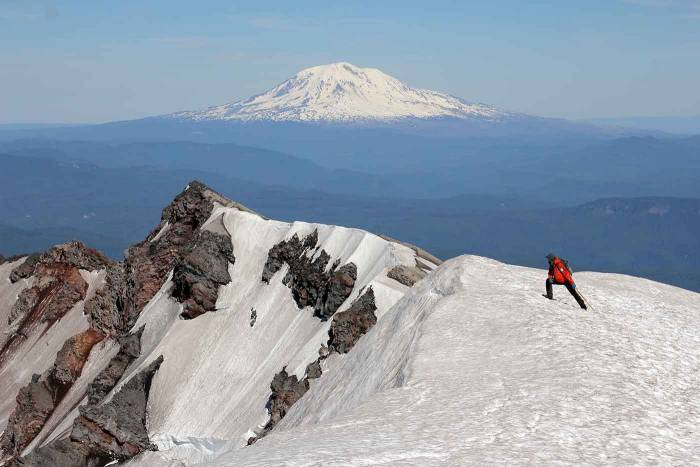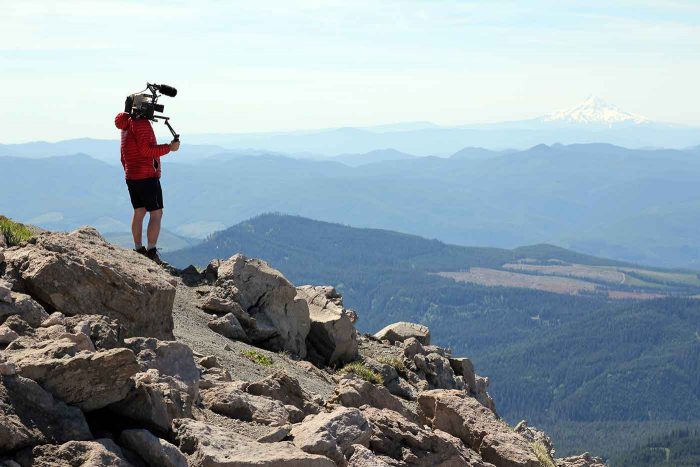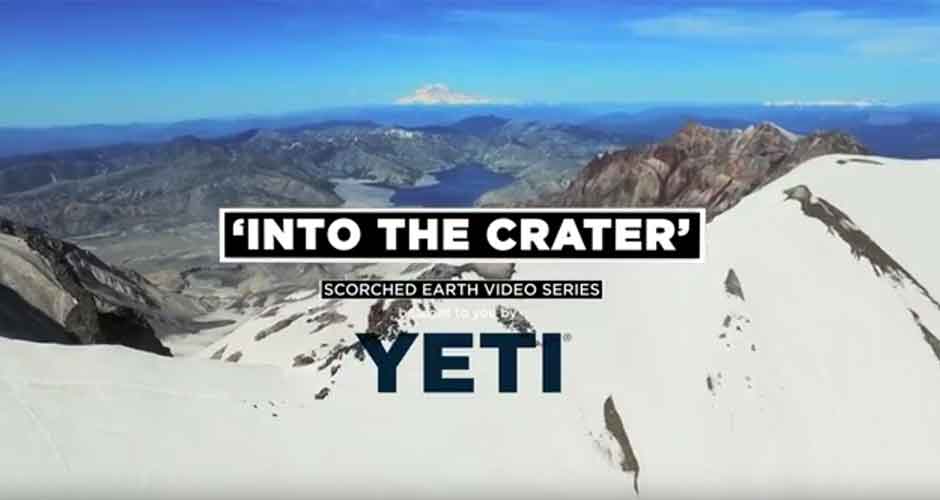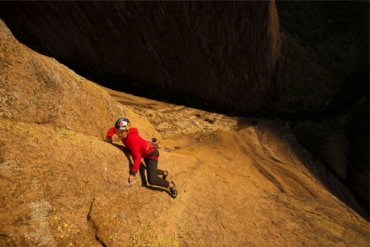The challenge: Climb a major Pacific Northwest peak (in this case a volcano) and capture it on film, including a look into the crater on Mount St. Helens.
In May of 1980, the eruption of Mount St. Helens rocked the world, its blast killing dozens of people, flattening forests, and decapitating a major Pacific Northwest peak. What remained was the shell of a mountain, a column of ash rising into the atmosphere. On top, the void of a massive crater smoked where 1,300 feet of rock, ice, and earth had existed just hours before.
Earlier this year, 36 years after the eruption, I geared up to climb St. Helens’ still-smoking mass. The goal was a two-day ascent and filming project, including a basecamp on the snow near 5,000 feet and then a meandering climb up multiple ridges to the top.

A part of the GearJunkie “Scorched Earth” series, the film would tell the story of Mount St. Helens through the lens of a climber, guide, and SAR professional named Jared Smith. A local legend of sorts, Smith has more than 300 ascents of the famous volcano (and dozens of mountain rescues) under his harness belt.
Film Project: Mount St. Helens
Our project, sponsored by YETI and a part of a series called “Scorched Earth,” had been arranged with the help of the Mount St. Helens Institute. We were permitted to climb and film by the U.S. Forest Service, and GearJunkie videographer Joshua Van Patter served as lead cameraman and operator for aerial shots.

From the Climber’s Bivouac trailhead, we packed heavy for the climb. In a ridiculous display, each hiker humped two backpacks and copious weight to ferry the requisite gear to film. Brandon Busey, a volunteer with the Mount St. Helens Institute, offered to serve as “head mule,” toting cameras, a tripod, and production equipment in an over-stuffed pack.
On Busey’s front was the hard-side case for the drone. Our aerial footage of St. Helens’ crater would require a bird’s eye view as well as navigation in wind and thin air.
From the trailhead at 3,700 feet, the route up follows the Ptarmigan Trail to an established area called Kiwi Camp. We took our time hoofing the loads to nearly 5,000 feet, soon hitting snowline and sighting Jared Smith’s hammock and fly on the slope above.
Gear To Climb (and Film)
Filming in the wilds takes a double dose of gear. You need all the products to accomplish the task plus cameras and equipment to document the experience. Filming disrupts climbing, as each shot requires a videographer to set up or run ahead, climb a ridge, and otherwise get the shot.
For St. Helens, looking to capture the volcano from several perspectives, Van Patter brought multiple “tools.” These included a RED Dragon camera, a DSLR unit, multiple lenses, a tripod, and the DJI Inspire One drone.

For “on the move” shots, we had two GoPro cameras and a new tool, the Osmo from DJI, which has a handheld gimbal camera that would adjust to keep steady as we hiked, climbed, and glissaded on the mountain’s flanks.
Batteries, memory cards, chargers, and a whole case of videographer erratum rounded out the haul.
As the sun set on day one, and with our camp prepared on the snow, we got into position. Golden hour shots are requisite for many filmmakers, and Van Patter moved above a ridge to catch a horizon fading toward night.
Next up, a drone flight, a close-up on Smith for an interview, then, with a microphone on, some storytelling around a fire completed the first day of the shoot.
Day two, we got up ahead of the sun. The summit was our goal by early afternoon. Smith led up a chute, kicking steps toward talus and a cliff above.
For some variety from the trade route, Smith ushered our crew toward a sub-peak adjacent to the much-climbed Monitor Ridge. A pyramid of stone, the secondary summit, called Monitor Peak, had been created during the eruption. It stands now as a jutting aberration on the volcano’s face.
Toward The Top
The RED camera is a beast of a unit, heavy and gangling to tote on flat land. Add snow and rock into the mix and the camera becomes a ball-and-chain on a climb. But for the high-def footage required, for the clearest, most epic shots, we needed the RED up there to film.
And so the crew took turns hoisting and moving with the camera. Busey hauled the drone on his back. Van Patter, directing the show, wore a pack full with the extra equipment needed that day.

On top of the sub-peak, where Smith had pulled out rock climbing gear to ascend a chimney pitch, we took in the view. The summit, still thousands of feet above, was a clean white slope.
A mountain goat stumbled through a talus field. The landscape below, a forest dotted with peaks, rolled to the horizon as a carpet of green.
Scree and ash dominate on St. Helens. Our crew kicked up snow, moved over a ridge, and skirted fields of loose stone, steep and unsteady to hike.
The Osmo camera, its head swiveling like a gyroscope, soaked in the scene. Hike, step, climb, scramble, the camera captures the movements like it’s on a track.

Close to the top, a weather station serves as a landmark and a strange waypoint on the climb. Then it’s up the slopes, an endless steep grade, kicking more steps, hauling the gear, getting close to the crater, which is many days still smoking above.
Summit Experience
St. Helens’ summit is a backwards place. A massive eruption will do that. Indeed, on the south face there is no normal top, simply an end to the slope then a drop more than 1,000 feet off the other side.

We climbed the final few hundred feet and waited for Mount Rainier to come into view. The biggest of the area’s volcanos, Rainier is hidden the whole climb until the ridge at the top.
You stare out at Rainier. You look down into the void. The crater, a strange, ashy expanse, drops from cornices toward an off-limits stewing floor.
A dome is slowly building, with magma pushing up from depths below. Steam and smoke are sporadic, and a massive lake in the distance filled with floating trees shows the ecological carnage of the eruption still today.

We launched the drone to get images from above. Wind blasted the ridge, but the quad-copter buzzed and flew high. Its camera recorded the scene, raw geology at the crater’s edge.
Smith clipped in and thrust an ice axe into the snow. He tied off, moving slowly toward St. Helens’ maw. Van Patter piloted the drone, its blades silent hundreds of feet in the air. We were on the top of a mountain, at the edge of a void, capturing an experience and a moment in time.
–See the full film, “Into The Crater,” a part of GearJunkie’s Scorched Earth series, sponsored by YETI. Thanks to guide Jared Smith and the Mount St. Helens Institute for support on the project and the climb.










